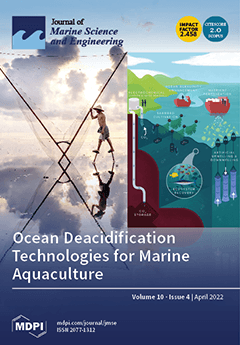This study evaluated the effects of seven diets composed of natural feed components (chopped fish, shrimp, and squid) alone or in combination on the liver metabolite profile of juvenile red drum (
Sciaenops ocellatus) cultured in a 24-tank recirculating aquaculture system over
[...] Read more.
This study evaluated the effects of seven diets composed of natural feed components (chopped fish, shrimp, and squid) alone or in combination on the liver metabolite profile of juvenile red drum (
Sciaenops ocellatus) cultured in a 24-tank recirculating aquaculture system over the course of 12 weeks using Nuclear Magnetic Resonance (NMR)-based metabolomics. Experimental diets included fish (F), shrimp (SH), squid (SQ), fish and shrimp (FSH), fish and squid (FSQ), shrimp and squid (SHSQ), fish, shrimp, and squid (FSHSQ). A commercial fishmeal-based pelleted diet was used as a control. Fish were fed isocalorically. Red drum liver samples were collected at five different time points: T0, before the start of the trial (
n = 12), and subsequently every 3 weeks over the course of 12 weeks (T3, T6, T9, T12), with
n = 9 fish/diet/time point. Polar liver extracts were analyzed by NMR-based metabolomics. Multivariate statistical analyses (PCA, PLS-DA) revealed that red drum fed the F diet had a distinct liver metabolite profile from fish fed the other diets, with those fed SH, SQ and the combination diets displaying greater similarities in their metabolome. Results show that 19 metabolites changed significantly among the different dietary treatments, including amino acids and amino acid derivatives, quaternary amines and methylamines, carbohydrates and phospholipids. Specifically, γ-butyrobetaine,
N-formimino-L-glutamate (FIGLU), sarcosine and beta-alanine were among the most discriminating metabolites. Significant correlations were found between metabolites and six growth performance parameters (final body weight, total length, condition factor, liver weight, hepatosomatic index, and eviscerated weight). Metabolites identified in this study constitute potential candidates for supplementation in fish feeds for aquaculture and optimization of existing formulations. Additionally, we identified a quaternary amine, γ-butyrobetaine as a potential biomarker of shrimp consumption in red drum. These results warrant further investigation and biomarker validation and have the potential for broader applicability outside of the aquaculture field in future investigations in wild red drum populations and potentially other carnivorous marine fishes.
Full article





